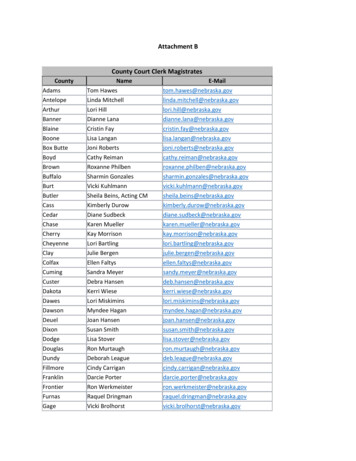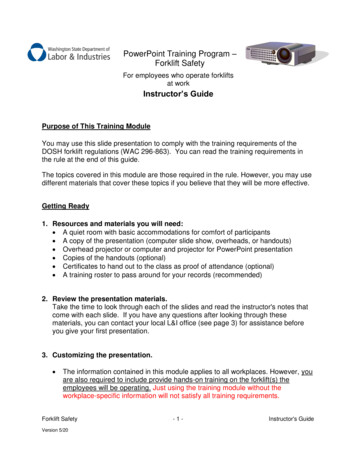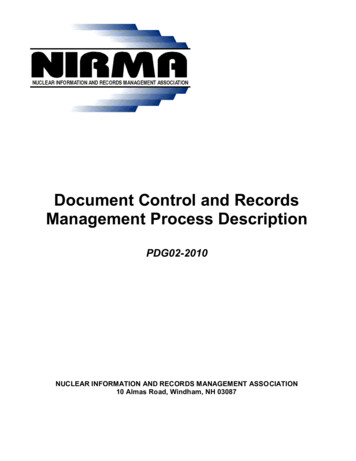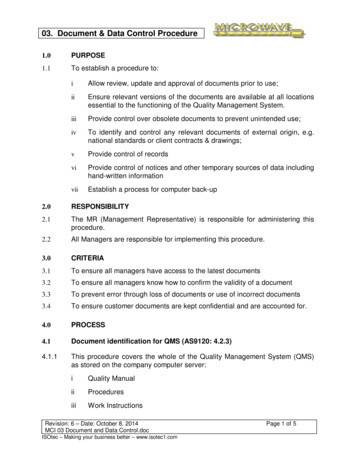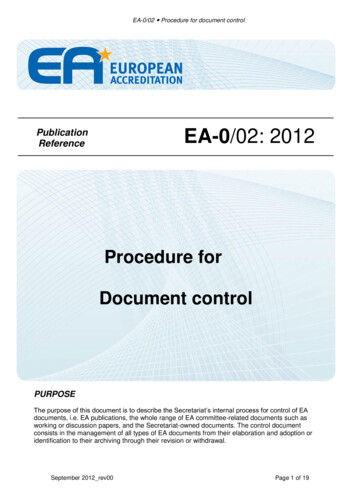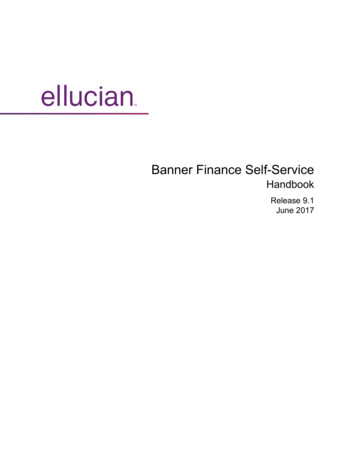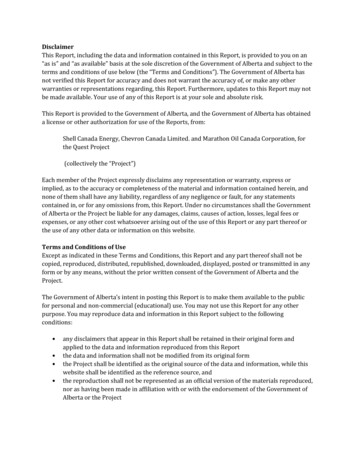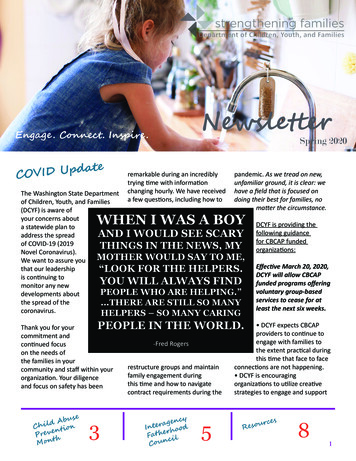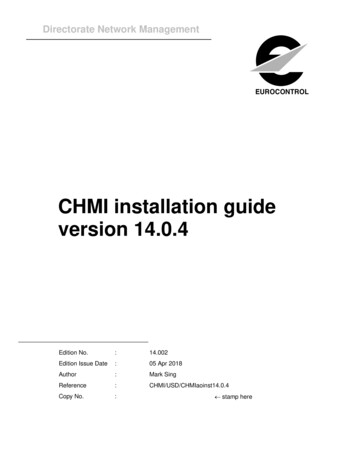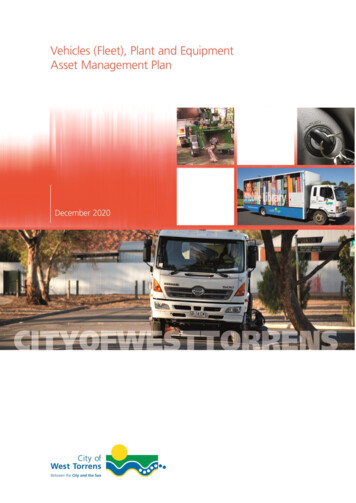
Transcription
Document ControlAsset Management PlanDocument ID :Rev No0DateRevision DetailsAuthorReviewerApproverDec 2020Issue for Executive ReviewRP, MPJIACDec 2020Issue to Elected Members- Preliminary DraftRP, MPJIACJan 2021Issue for Public Consultation - DraftRP, MPJICouncil Resolution19/1/21Feb 2021Issue for Council AdoptionRP, MPJIACMar 2021Issue Adopted by Council - FinalRP, MPJICouncil Resolution2/3/21The entity can choose either template to write/update their plan regardless of their level of asset managementmaturity and in some cases may even choose to use only the Executive Summary.The illustrated content is suggested only and users should feel free to omit content as preferred (e.g. whereinfo is not currently available).This Asset Management Plan may be used as a supporting document to inform an overarching Strategic AssetManagement Plan. Copyright 2020 – All rights reservedThe Institute of Public Works Engineering Australasia2
Contents1.0EXECUTIVE SUMMARY51.1The Purpose of the Plan . 51.2Asset Description . 51.3Levels of Service. 51.4Future Demand . 51.5Lifecycle Management Plan . 61.6Financial Summary . 61.7Asset Management Planning Practices . 71.8Monitoring and Improvement Program . 72.0Introduction2.1Background . 82.2Goals and Objectives of Asset Ownership . 93.0LEVELS OF SERVICE3.1Customer Research and Expectations . 123.2Strategic and Corporate Goals . 143.3Legislative Requirements . 143.4Customer Values . 153.5Customer Levels of Service . 163.6Technical Levels of Service. 164.0FUTURE DEMAND4.1Demand Drivers . 194.2Demand Forecasts . 194.3Demand Impact and Demand Management Plan . 194.4Asset Programs to meet Demand . 204.5Environmental Sustainability . 205.0LIFECYCLE MANAGEMENT PLAN5.1Background Data . 225.2Operations and Maintenance Plan . 255.3Renewal Plan . 265.4Summary of future renewal costs. 295.5Acquisition Plan . 295.6Disposal Plan . 316.0RISK MANAGEMENT PLANNING8121922323
6.1Critical Assets . 326.2Risk Assessment . 326.3Organisation Strategic Risks . 356.4Service and Risk Trade-Offs . 367.0FINANCIAL SUMMARY7.1Financial Sustainability and Projections . 377.2Funding Strategy . 387.3Valuation Forecasts . 387.4Key Assumptions Made in Financial Forecasts . 387.5Forecast Reliability and Confidence . 398.0PLAN IMPROVEMENT AND MONITORING8.1Status of Asset Management Practices . 418.2Improvement Plan . 418.3Monitoring and Review Procedures . 428.4Performance Measures . 429.0REFERENCES4310.0APPENDICES443741Appendix ARenewal Forecast . 44Appendix BAcquisition Forecast . 50Appendix CForecast Expenditure and Long Term Financial Plan . 514
1.0EXECUTIVE SUMMARY1.1The Purpose of the PlanThis Asset Management Plan (AM Plan) details information about infrastructure assets with actions required toprovide an agreed level of service in the most cost-effective manner while outlining associated risks. The plandefines the services to be provided, how the services are provided and what funds are required to provide overthe 2020/21 to 2029/30 year planning period. The AM Plan will link to a Long-Term Financial Plan whichtypically considers a 10 year planning period.1.2Asset DescriptionThis plan covers the infrastructure assets that assist with a variety of operations and delivery of services to thecommunity.The vehicles, plant and equipment network comprises: Light passenger and commercial vehicles Trucks and buses Construction plant and equipment Mowing and parks maintenance plant and equipment Other motorised mobile or portable equipmentThe above infrastructure assets have replacement value estimated at 11,277,683 (2020).1.3Levels of ServiceThe allocation in the planned budget is sufficient to continue providing existing services at current levels for theplanning period. There are no major service consequences as a result of the planned budget.1.4Future DemandThe factors influencing future demand and the impacts they have on service delivery are created by: Population Operator/ Driver Expectations Changes in community demands Environmental AwarenessThese demands will be approached using a combination of managing existing assets, upgrading existing assetsand providing new assets to meet demand. Demand management practices may also include a combination ofnon-asset solutions, insuring against risks and managing failures. The utilisation rates of vehicles, plant and equipment will continue to be monitored to assist with thedecision making for the acquisition of new assets to suit a growth in demand for services. Utilisation reporting is to be refined and improved to assist with the decision making for the acquisition ofnew assets. The acquisition of new vehicle, plant and equipment purchases as well as retrofitting existing assets willneed to be assessed to determine whether the improved productivity and safety is worth the increasedwhole of life cycle cost from the existing assets available. The technological advancements in vehicles, plant and equipment will continue to be monitored andassessed to assist with the decision making for asset acquisitions5
1.5Lifecycle Management Plan1.5.1 What does it Cost?The forecast lifecycle costs necessary to provide the services covered by this AM Plan includes operation,maintenance, renewal, acquisition, and disposal of assets. Although the AM Plan may be prepared for a rangeof time periods, it typically informs a Long-Term Financial Planning period of 10 years. Therefore, a summaryoutput from the AM Plan is the forecast of 10 year total outlays, which for vehicles, plant and equipment isestimated as 23,766,360 or 2,376,636 on average per year.1.6Financial Summary1.6.1 What we will doEstimated available funding for the 10 year period as 25,305,280 or 2,530,528 on average per year. onaverage per year as per the Long-Term Financial plan or Planned Budget. This is 106.88% of the cost to sustainthe current level of service at the lowest lifecycle cost.The infrastructure reality is that only what is funded in the long-term financial plan can be provided. TheInformed decision making depends on the AM Plan emphasising the consequences of Planned Budgets on theservice levels provided and risks.The anticipated Planned Budget for fleet, plant and equipment leaves a surplus of 153,892 on average peryear of the forecast lifecycle costs required to provide services in the AM Plan compared with the PlannedBudget currently included in the Long-Term Financial Plan. This is shown in the figure below.Forecast Lifecycle Costs and Planned BudgetsFigure Values are in current dollars.We plan to provide services for the operation, maintenance, renewal and acquisition of fleet, plant andequipment to meet service levels set by the City of West Torrens and detailed in this AM plan.6
1.6.2 What we cannot doThe current level of funding is sufficient to maintain the current level of service.1.6.3 Managing the RisksOur present budget levels are sufficient to continue to manage risks in the medium term.The main risk consequences are: Fleet, plant and equipment breakdown or reduction in service output leading to significant productivitylosses. Fleet, plant and equipment is not safe for use and results in injury or damage to propertyWe will endeavour to manage these risks within available funding by:1.7 Further developing asset renewal criteria to assist with the decision making for asset renewals. Inparticular, determination of the optimum timing of replacement to minimise risk of asset downtime. Improve reporting on key performance indicators to Management and Supervisors for all asset inspectionsand maintenance activities to ensure services levels are being met and maintenance practices are beingundertaken in accordance with this AMP.Asset Management Planning PracticesKey assumptions made in this AM Plan are: Vehicle, Plant and Equipment are replaced on a "like for like" basis Community levels of service remain consistent over the period Operations and maintenance budget and budget growth levels remain consistent with historical figuresAssets requiring renewal are identified from either the asset register or an alternative method. The timing of capital renewals based on the asset register is applied by adding the useful life to the year ofacquisition or year of last renewal, Alternatively, an estimate of renewal lifecycle costs is projected from external condition modelling systemsand may be supplemented with, or based on, expert knowledge.The renewal lifecycle costs for this AM Plan are based on actual replacement costs.This AM Plan is based on a medium level of confidence information.1.8Monitoring and Improvement ProgramThe next steps resulting from this AM Plan to improve asset management practices are: Undertake a review of the current method for determining useful lives and actual asset useful livesaccordingly Develop current methods of measuring and reporting regularly on key performance indicators. Review criteria for asset renewals and update the 10 year asset renewal program. Undertake a complete review of this asset management plan at least every four years.7
2.0Introduction2.1BackgroundThis AM Plan communicates the requirements for the sustainable delivery of services through management ofassets, compliance with regulatory requirements, and required funding to provide the appropriate levels ofservice over the planning period.The AM Plan is to be read with the City of West Torrens planning documents. This should include the AssetManagement Policy and Asset Management Strategy, where developed, along with other key planningdocuments: City of West Torrens Community Plan Long Term Financial Plan Annual Business PlanThe infrastructure assets covered by this AM Plan include fleet, plant and equipment. For a detailed summaryof the assets covered in this AM Plan refer to Table in Section 5.These assets are used to assist with providing a variety of operations and delivery of services to the community.The infrastructure assets included in this plan have a total replacement value of 11,277,683.The City of West Torrens is committed to adopting an environmentally sustainable approach to managing ourassets. This is done by minimising the impact of our assets on the environment and by considering theenvironmental and climate change issues over the entire life of assets.We need to be aware of the challenges we face now and in the future - such as population growth,demographic change, climate change, technology change and changes in our community’s needs andaspirations.Council recognises that climate change is likely to affect asset life and functionality. As such, in future reportsand analysis Council will further explore how climate change will affect assets.Key stakeholders in the preparation and implementation of this AM Plan are shown in Table 2.1.Table 2.1: Key Stakeholders in the AM PlanKey StakeholderElected MembersRole in Asset Management Plan Represent needs of community/shareholders; and Ensure organisation is financially sustainable.CEO/ General Manager UrbanServicesExecutive management endorsement of AM PlanManager City AssetsReview and approval of AM PlanTeam Leader Asset and ProjectManagementDevelopment, implementation and maintenance of AM Plan to meetcommunity levels of service.Asset Officer/ EngineerAssist with the development, implementation and maintenance ofAM Plan to meet community levels of service.City Operations DepartmentCoordinate and deliver maintenance, renewal and operation works inaccordance with the AM Plan.8
General publicAssist with the determining of levels of service through publicconsultation processes.Operators/ users of fleet, plant andequipmentAssist with the determining of levels of service through publicconsultation processes.Our organisational structure for service delivery from infrastructure assets is detailed below,VACANCY2.2Goals and Objectives of AssetOwnershipOur goal for managing infrastructure assets is to meet the defined level of service (as amended from time totime) in the most cost effective manner for present and future consumers. The key elements of infrastructureasset management are: Providing a defined level of service and monitoring performance, Managing the impact of growth through demand management and infrastructure investment, Taking a lifecycle approach to developing cost-effective management strategies for the long-term thatmeet the defined level of service, Identifying, assessing and appropriately controlling risks, and Linking to a Long-Term Financial Plan which identifies required, affordable forecast costs and how it will beallocated.Key elements of the planning framework are Levels of service – specifies the services and levels of service to be provided, Risk Management,9
Future demand – how this will impact on future service delivery and how this is to be met, Lifecycle management – how to manage its existing and future assets to provide defined levels of service, Financial summary – what funds are required to provide the defined services, Asset management practices – how we manage provision of the services, Monitoring – how the plan will be monitored to ensure objectives are met, Asset management improvement plan – how we increase asset management maturity.Other references to the benefits, fundamentals principles and objectives of asset management are: International Infrastructure Management Manual 2015 1 ISO 550002A road map for preparing an AM Plan is shown below.12Based on IPWEA 2015 IIMM, Sec 2.1.3, p 2 13ISO 55000 Overview, principles and terminology10
Road Map for preparing an Asset Management PlanSource: IPWEA, 2006, IIMM, Fig 1.5.1, p 1.1111
3.0LEVELS OF SERVICE3.1Customer Research and ExpectationsThe City of West Torrens is committed to meeting community expectations through asset management.Feedback was received from the community relating to Council's current state of infrastructure assets fromrecent city-wide community engagement initiatives, which include: City of West Torrens Community Needs Analysis 2019/20 (CNA) City of West Torrens Customer Experience Strategy 2018 (CES)3.1.1 Engagement participation rate175882engagementparticipants707Community NeedsAnalysis 2019/20Customer ExperienceStrategy 2018The 2019 Community Needs Analysis Community Survey (with 410 participants) asked respondents to rank tencouncil services in order of importance. The chart below shows combined priorities for all survey participants,with priority percentage scores ranked relative to the highest scoring service, ‘parks and open spaces’.Parks and open spaces100%Walking conditions82%Waste management and recycling81%Climate change adaptation measures76%Community programs63%Cycling conditions62%Encouraging businesses and tourism54%Support to community groups54%Sporting and recreational facilities54%Encouraging local employment51%Ranking of importance of 10 services to engagement participantsParks and open spaces, walking conditions, cycling conditions and recreational facilities were all ranked of highimportance by the majority of survey participants.The Community Needs Analysis survey asked respondents to rate the current level of service for 20 servicesprovided by the City of West Torrens, including local parks, open spaces and outdoor recreation areas, walkingconditions and cycling conditions. The three charts below show the results.12
Local parks, openspaces and outdoorrecreational areas11%2%Conditions for walking22%28%Conditions for equateDon’t knowInadequateAdequateExcellentAdequateDon’t knowInadequateLevel of service assessment by survey respondentsThe access to vehicle, plant and equipment resources directly affects Council's ability to provide, maintain andoperate its assets. In particular, this includes Council's ability to maintain its parks, open spaces, recreationalfacilities, footpaths and shared user paths.Overall, there were 20 services ranked in the survey and the rankings for the three relevant services were thefollowing: Local parks, open spaces and outdoor recreational areas – 2nd , with 11% of the respondents rankingservices to be inadequate Walking – 8th, with 22% of the respondents ranking services to be inadequate Cycling – 12th, with 20% of the respondents ranking services to be inadequate.Table 3.1 summarises the results from the Community Needs Analysis and Customer Experience Strategyengagement initiatives.Table 3.1: Customer Satisfaction Survey LevelsSatisfaction LevelPerformance MeasureLocal parks, open spaces andoutdoor recreation areasConditions for walkingConditions for atsatisfiedNotsatisfied80 - 100%60 - 80%40 - 60%20 - 40%0 - 20% 13
3.2Strategic and Corporate GoalsThis Asset Management Plan is prepared under the direction of the City of West Torrens vision, mission, goalsand objectives.Our vision is:Committed to be being the best place to live, work and enjoy life.Our mission is:To strive for excellence in serving our diverse community.Strategic goals have been set by the City of West Torrens. The relevant goals and objectives and how these areaddressed in this Asset Management Plan are summarised in Table 3.2.Table 3.2: Goals and how these are addressed in this PlanCouncil VisionOperational Focus- Strong partnerships andworking relationships with ourcommunity, otherorganisations and spheres ofGovernmentOrganisationalStrengthAs part of the improvement plan, methods are to beestablished to measure key performance indicatorsregularly including customer satisfaction levels.- Customer experience andcommunity are at the centre ofour considerations- Our community canmeaningfully engage withCouncil- Sustainable financialmanagement principlesBuiltEnvironmentHow Goal and Objectives are addressed in the AMPlan- A variety of indoor andoutdoor sport, recreation andcommunity facilities and openspaces- Provide infrastructure thatmeets the needs of a changingcity and climateAs part of this AM plan, the levels of service ofvehicles, plant and equipment assets have beenreviewed to ensure that service levels are financiallysustainable based on funding available.As part of this AM plan, the acquisition, renewal andmaintenance levels of service of vehicles, plant andequipment have been reviewed to ensure that it isadequate to support the built environment and meetthe needs of the city through the efficientmanagement of Council-owned infrastructure.- Reduce the City's impact onthe environmentEnvironmentalandsustainability3.3- Prepare for and respond tothe challenges of a changingclimateAs part of this AM plan, the acquisition and renewal ofhybrid and electric vehicles has been allowed for inthe forecast lifecycle expenditure.Legislative RequirementsThere are many legislative requirements relating to the management of assets. Legislative requirements thatimpact the management of road assets are listed in Table 3.3.14
Table 3.3: Legislative RequirementsLegislation3.4RequirementSouth Australian LocalGovernment Act 1999Sets out role, purpose, responsibilities, and powers of localgovernments including the preparation of a LTFP supported by assetmanagement plans for sustainable service delivery.Australian Accounting StandardsSets out the financial reporting standards relating to assets within theLocal Government Environment.South Australian State RecordsAct 1997To ensure the City of West Torrens records and stores all relevantinformation as set out by the State Government of South Australia.Environmental Protection Act1993An Act to provide for the protection of the environment: to establishthe Environmental Protection Authority and define functions andpowers and for other purposes.Work Health and Safety Act 2012To take a constructive role in promoting improvements in work healthand safety practices whilst assisting in the preservation of public healthand safety in all undertakings of the organisation.Australian Road Rules 1989The Australian Road Rules have been made into regulations under theRoad Traffic Act (South Australia) and gives road authorities in eachstate delegated power to establish standards for all aspects ofroadways, including bridges and shared use paths.Australian Design RulesThe Australian Design Rules are national Australian standards forvehicle safety, anti-theft system and emission standards.Customer ValuesService levels are defined in three ways, customer values, customer levels of service and technical levels ofservice.Customer Values indicate: what aspects of the service is important to the customer, whether they see value in what is currently provided and the likely trend over time based on the current budget provisionTable 3.4: Customer ValuesService Objective:Provide vehicles, plant and equipment which are safe, fit for purpose and assist with the efficient delivery of servicesto the community.Customer SatisfactionExpected Trend Based onCustomer ValuesCurrent FeedbackMeasurePlanned BudgetVehicle presentationFrequency of vehiclecleaningMonthly or as deemedrequired by driver/ operatorThe current performance isexpected to be maintained.Efficiency andsuitability of vehicles,plant and equipmentCustomer satisfaction forthe safety and conditionof public spaces (e.g.parks, playgrounds,footpaths etc.)83% customer satisfaction(2019)The current performance isexpected to be maintained.15
3.5Customer Levels of ServiceThe Customer Levels of Service are considered in terms of:QualityHow good is the service what is the condition or quality of the service?FunctionIs it suitable for its intended purpose . Is it the right service?Capacity/UseIs the service over or under used do we need more or less of these assets?In Table 3.5 under each of the service measures types (Quality, Function, Capacity/Use) there is a summary ofthe performance measure being used, the current performance, and the expected performance based on thecurrent funding level.These are measures of fact related to the service delivery outcome e.g. number of occasions when service isnot available, condition %’s of Very Poor, Poor/Average/Good, Very Good and provide a balance in comparisonto the customer perception that may be more subjective.Table 3.5: Customer Level of Service MeasuresType ofMeasureConditionFunctionCapacityLevel of ServiceProvide a fleetwhich ismaintained ingood conditionand operational.ConfidencelevelsProvide a fleetthat supportsthe requiredoperations ofCouncil.ConfidencelevelsProvide a fleetof size andfunction whichsuits formanceMeasureNumber d operation.The capacityof vehicles,plant andequipmentavailable.Hours workedor distancetravelled in acalendar year.Current PerformanceExpected Trend Based onPlanned BudgetThe current performanceis acceptable.The current performance isexpected to be maintained.LowLowThere is adequate assetsavailable to deliver thedesired operations levelsof service.The current performance isexpected to be maintained.MediumMediumThe current performancegenerally coincides withthe national benchmarkfor asset utilisation fromthe IPWEA Plant andVehicle ManagementManual (Table 1.1).MediumThe current performance isexpected to be maintained.MediumTechnical Levels of ServiceTechnical Levels of Service – To deliver the customer values, and impact the achieved Customer Levels ofService, are operational or technical measures of performance. These technical measures relate to theactivities and allocation of resources to best achieve the desired customer outcomes and demonstrateeffective performance.16
Technical service measures are linked to the activities and annual budgets covering: Acquisition – the activities to provide a higher level of service (e.g. widening a road, sealing an unsealedroad, replacing a pipeline with a larger size) or a new service that did not exist previously (e.g. a newlibrary). Operation – the regular activities to provide services (e.g. opening hours, cleansing, mowing grass, energy,inspections, etc. Maintenance – the activities necessary to retain an asset as near as practicable to an appropriate servicecondition. Maintenance activities enable an asset to provide service for its planned life (e.g. road patching,unsealed road grading, building and structure repairs), Renewal – the activities that return the service capability of an asset up to that which it had originallyprovided (e.g. road resurfacing and pavement reconstruction, pipeline replacement and buildingcomponent replacement),Service and asset managers plan, implement and control technical service levels to influence the serviceoutcomesTable 3.6 shows the activities expected to be provided under the current Planned Budget allocation, and theForecast activity requirements being recommended in this AM Plan.Table 3.6: Technical Levels of ServiceLifecycleActivityPurpose ofActivityActivity MeasureCurrentPerformance*RecommendedPerformance **Predominately basedon changes in demandand asset utilisation.As required to meetnational benchmark fromthe IPWEA Plant a
The anticipated Planned Budget for fleet, plant and equipment leaves a surplus of 153,892 on average per year of the forecast lifecycle costs required to provide services in the AM Plan compared with the Planned Budget currently included in the Long-Term Financial Plan. This is shown in the figure below. Forecast Lifecycle Costs and Planned .
